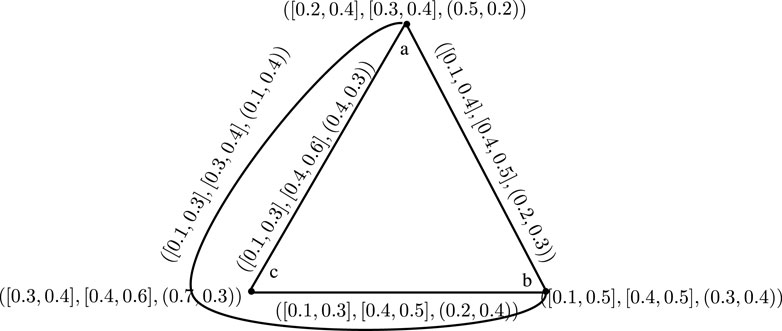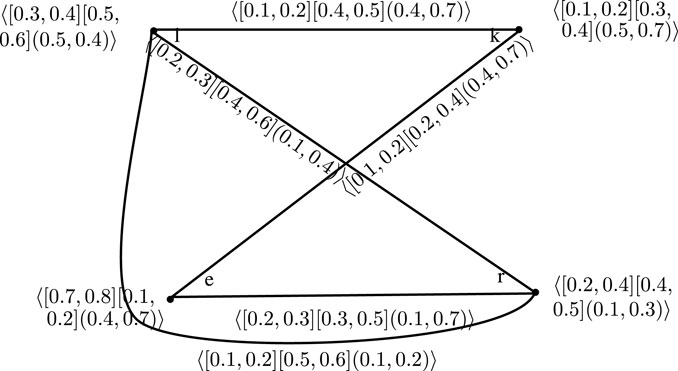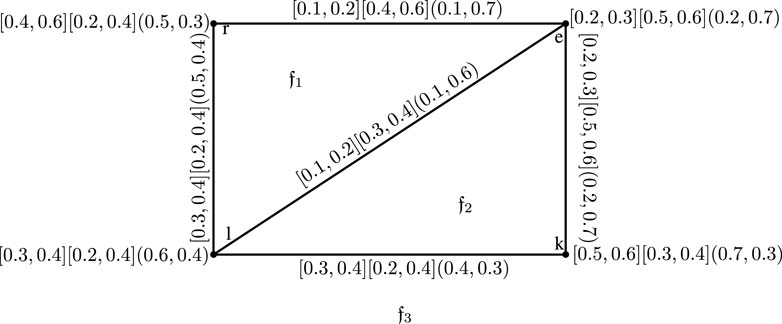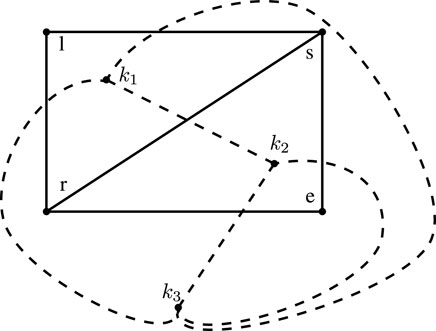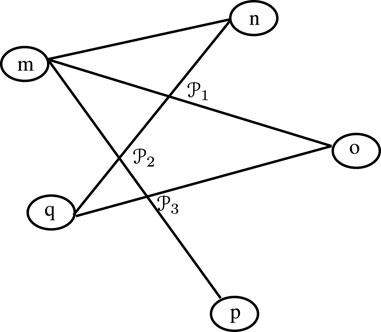- 1Institute of Computing Science and Technology, Guangzhou University, Guangzhou, China
- 2Department of Mathematics, University of the Punjab, Lahore, Pakistan
- 3Department of Mathematics, Prince Sattam Bin Abdulaziz University, Al-Kharj, Saudi Arabia
- 4Department of Computer Science, College of Arts and Science, Prince Sattam Bin Abdul Aziz University, Al-Kharj, Saudi Arabia
Fuzzy modeling plays a pivotal role in various fields, including science, engineering, and medicine. In comparison to conventional models, fuzzy models offer enhanced accuracy, adaptability, and resemblance to real-world systems and help researchers to always make the best choice in complex problems. A type of fuzzy graph that is widely used in medical and psychological sciences is the cubic intuitionistic fuzzy graph, which plays an important role in various fields such as computer science, psychology, medicine, and political sciences. It is also used to find effective people in an organization or social institution. In this research endeavor, we embark upon elucidating the innovative notion of a cubic intuitionistic planar graph, delving into its intricate properties and attributes. Additionally, we unveil the novel concept of a cubic intuitionistic dual graph, thus enriching the realm of graph theory with further profundity. Furthermore, our exploration encompasses the elucidation of other pertinent terminologies, such as cubic intuitionistic multi-graphs, along with the categorization of edges into the distinct classifications of strong and weak edges. Moreover, we discern the concept of the degree of planarity within the context of CIPG and unveil the notion of strong and weak faces. Additionally, we delve into the construction of cubic intuitionistic dual graphs, which can be realized in cases where the initial graph is planar or possesses a degree of planarity
1 Introduction
Graph theory has significantly grown in importance as a field of study due to its widespread applications. The significance of graph theory has escalated, owing to its versatile uses. For instance, it plays a crucial role in calculating the shortest path between two nodes in services like Google Maps. Graph theory finds applications in various domains, such as computer networks, image processing, electric circuits, and road networks. For applications of graph theory in chemistry, refer to [1–4].
In certain graph networks, intersections between edges give rise to problems, such as planning issues for electrical circuits, metros, and utility corridors. The elimination of crossings between electric wires might be feasible, but avoiding such crossings in a road network is often more complex. In road networks, nodes represent specific locations and edges symbolize highways. Hence, it becomes critical to determine the necessity of road crossings. The solution of this problem may involve the construction of underpasses or flyovers, but this may result in higher costs. However, this approach effectively resolves numerous issues, including road accidents and traffic jams that arise in congested areas. It is important to note that the term “congested” is a linguistic expression without precise boundaries. Various degrees of congestion, such as “very highly congested,” “very congested,” “congested,” “low congested,” and “very low congested,” can be employed. Additionally, these linguistic terms are associated with membership values, allowing for a more nuanced representation of congestion levels.
Strong and weak routes are distinguished by their congestion levels, with strong routes being congested and weak routes remaining non-congested. When developing a city road network, intersections between two weak routes hold significance, while intersections between two strong routes can be inconvenient. These problems can be effectively addressed using a fuzzy planar graph. In 1964, Zadeh [5] recognized the lack of clarity and ambiguity in real-world problems, leading to the introduction of fuzzy sets. This advancement has transformed the landscape of science and technology, especially when dealing with partial information or inaccessible data, leading to the emergence of fuzzy theories.
The concept of fuzzy graph theory was introduced by Rosenfeld [6], marking the beginning of fuzzy research. Kaufmann [7] introduced the theory of fuzzy graphs (FGs) based on fuzzy relations. Mordeson and Nair [8] introduced the FG complement and its associated operations. Shannon and Atanassov [9] introduced the intuitionistic fuzzy relation (IFR) and intuitionistic fuzzy graph (IFG) as its foundation. Parvathi et al. [10] introduced various operations on IFGs, such as union and join. The study of intuitionistic fuzzy cycles related to IFGs was conducted in [11]. Jabbar et al. [12] introduced the concept of fuzzy dual graphs, while Samanta and Pal [13] introduced fuzzy planar graphs. Alshehri and Akram [14], and Akram et al. [15] introduced intuitionistic and Pythagorean fuzzy planar graphs. Nirmal and Dhanabal [16] discussed specific fuzzy planar graphs in non-deterministic polynomial time. Pal et al. [17] examined planarity in FGs and proposed an alternative approach without restricting edge crossings. For various applications of fuzzy graphs, refer to [18–35].
Zadeh [36] presented interval-valued fuzzy sets (IVFS) as extension of fuzzy sets. Akram and Dudek [37] described the basic concepts of the interval-valued fuzzy graph (IVFG). These IVFGs were further studied in [38]. The notion of the IVFG is perhaps more generalized and flexible than a fuzzy graph because the membership degrees of vertices and edges are in the form of intervals. The interval-valued intuitionistic fuzzy graphs were discussed in [39]. In [40], interval-valued intuitionistic fuzzy competition graphs are investigated. Pramanik et al. [41] proposed interval-valued planar graphs. On the other hand, the cubic set proposed by Jun et al. [42] is a blending of ideas of IVFS and a fuzzy set. During recent 5 years, a lot of research work has been performed in the domain of the cubic set. Rashid et al. [43] presented the basic theory of cubic graphs. Khan et al. [44] investigated cubic intuitionistic FGs. The cubic planar graphs have been studied by Muhiuddin et al. [45]. They also applied the planarity of cubic graphs in a road network problem. In [46], the cubic Pythagorean FGs were investigated. The vertex regularity for cubic fuzzy graph structures is investigated in [47].
1.1 Motivation
Cubic sets serve as a primary motivation for this study as they can effectively handle two types of processes simultaneously: one continuous and the other specific. Although a discrete process may demonstrate a present value, a continuous process can provide future or past estimates. Previous research has extensively explored cubic sets, but there has been relatively less focus on cubic graphs. In this study, we aim to integrate the planarity of both graphs, namely, IVFG and FG, into a single structure. The concept of a cubic planar graph also serves as a motivating factor for our research.
The following work on cubic intuitionistic planar graphs is discussed and coordinated as follows:
Section 2 provides several basic terms related to CIMS and CIMG. The concepts of strong and weak edges are defined for cubic intuitionistic graphs. Section 3 discusses the planarity of CIPG and other essential results. We define strong and weak faces and use them to define the cubic intuitionistic dual graph of a CIPG. Section 5 contains an application of a CIPG related to an airline route system. We also compare our result with cubic planar graphs.
2 Preliminaries
Definition 2.1. [5, 7]. Consider a non-empty set
In addition, with a mapping
A pair
for all
Definition 2.2. [48]. Consider a non-empty set
such that
Definition 2.3. [49]. Consider a mapping
where
for all
Consider the mappings
such that
Definition 2.4. A cubic multi-set is a combination of IVFMS and FMS expressed as
where
Definition 2.5. [50]. Take the mappings
where
along with
and
such that
Definition 2.6. A count membership function and a count non-membership function define an intuitionistic fuzzy multi-set (IFMS) and is described as
where a = 1, 2, … , qt and
Definition 2.7. [51]. Consider the mappings
such that
along with the mappings
for all
Definition 2.8. A count membership function
where a = 1, 2, … , qp and
3 Cubic intuitionistic planar graph
Definition 3.1. [44]. A graph that contains both IFS and IVIFS, as defined by the cubic intuitionistic fuzzy set (CIFS):
where IVIFS is
is a cubic intuitionistic fuzzy relation on
and
Definition 3.2. IVIFMS
and
Example 3.3. Let
Definition 3.4. The strength of an edge for an ICMG
where the edge strength for the membership value is represented by
When using the ICMG, the intersection of two edges provides a specific value. This amount is known as a intuitionistic cubic-valued number. If two edges (l, k) and (e, r) cut each other at the point
A graph containing no cutting points between the edges is a planar graph. Planarity is affected by the number of cutting edges. If the number of cutting edges is greater, planarity is reduced, and vice versa. This motivates to introduce the concept of an intuitionistic cubic planar graph.
Definition 3.5. Suppose
where
Here, we can observe
A graph without any cutting point have a planarity value ⟨ [18][1, 1](1, 1)⟩. The cutting point between edges increases if
Example 3.6. Take
So, Ilr = ⟨[0.5, 0.75][0.66, 1](1, 1)⟩. By repeating the same technique for the edge (k, e), we obtain Ike = ⟨[0.5, 1][0.5, 1](1, 1)⟩.
Similarly,
Next, we evaluate the valueofplanarity as
Theorem 3.7. The value of planarity is
Strong cubic intuitionistic planar graphs (SCIPGs) are graphs that have a cubic planarity value of at least 0.5 for their membership parts, and the non-membership component is less than or equal to 0.5. Alternatively, we have
Theorem 3.8. The number of cutting points between the strong edges for SCIPG is at most 1.
Proof. Consider two cutting points
Theorem 3.9. Consider a CIPG
Proof. Now, we take a CIPG
Definition 3.10. Consider a rational number 0 ≤ c ≤ 0.5 for a CIPG. Then, an edge (l, k) is an considerable edge if
Remark: The number c is known as the considerable number if every edge is considerable. c assumes a specific pre-assigned value depending on the problem or an application. This pre-assigned number may or may not be unique.
Theorem 3.11. For a CIPG
Proof. Consider a strong CIPG
Here, the set of integers is denoted by Z.
The area covered by the edges is known as the faces of the graph. These faces of the graph can be categorized into two types: one is the outer face and the other is the inner face. The area surrounded by some specific edges and limited region is known as the inner face. The unlimited zone surrounded by the side edges of the graph is known as the outer face. A graph with the planarity value [18], [0, 0](1, 0) is known as a crisp planar graph. By assigning the degree of planarity
Definition 3.12. Let
Example 3.13. A graph displayed in Figure 3 is a CIPG. It contains faces
This implies that the strength of
4 Cubic intuitionistic dual graph
In this section, the notion of a cubic intuitionistic dual graph (CIDG) is presented. We can draw a CIDG only if the graph is either planar or have planarity measure
Definition 4.1. Let
It is noted that two faces may share more than one common edge. As a result, vertices of the CIDG may have several edges crossing them. If
where v = 1, 2, … , k and k is the number of common edges. The pendant vertex in the CIPG is associated with a loop in the CIDG with the degrees of membership and non-membership being the same as that of the pendant vertex. According to the value of planarity [18][0, 0](1, 0), the graph CIDG is always planar. By taking the vertices of the CIDG as the faces and the edges as the edges of the CIPG, we may create the CIPG from the CIDG.
Example 4.2. Let
The membership and non-membership values of the new edges are calculated as:
Theorem 4.3. We consider a CIPG
1.
2.
3.
5 Application to the airline system
In the past, individuals had to take a ship or a land vehicle, which was exhausting and time-consuming. The likelihood of becoming lost or getting into an accident increases as a result. The emergence of the airline system, a quick mode of transportation that is especially helpful when on a strict timetable, has all but eliminated this issue. Airline routes occasionally cross paths (intersection) which can either be eliminated or not depending on the degree of planarity.
The airline route system is represented in Figure 5. The vertices of this diagram denote the countries, and its edges stand in for the air routes that link them. Here, the vertices have values ⟨[0.5, 0.5][0.5, 0.5](0.5, 0.5)⟩, or in other words, have half degrees of membership and non-membership. Now, we select the level of membership and non-membership for edges, which depends on a range of variables including the ticket prices, the frequency of flights, festivals, and more. There may be more flights on that route and more passengers traveling by the plane if the ticket price is affordable, increasing the likelihood of an encounter. There will be more travel as a result. The major issue, which is the crowd of people or the number of flights, is connected to all of these elements in some manner. As a result, chosen from the closed interval [0,1], the degree of membership and non-membership among edges will be vague or unclear.
A CIPG is connected to both a continuous and a particular operation. Although a fuzzy interval denotes a continuous process, a fuzzy number denotes a discrete process. So using the present as a number and the future as an interval, we examine the path’s intersection at both the current and future dates. There is a possibility that there is a crossover that is currently unavailable will be required some other day; similarly, there would be a situation that a currently blocked intersection due to a festival or other circumstance may be needed in future. Table 4 demonstrates the edge membership and non-membership degree.Because the intersection might increase with the number of aircraft every day, there is a direct correlation between the crowd and the intersection. We utilize the approach in Table 5 to determine the degree of planarity.From Figure 5, it is evident that
So Iqn = ⟨[0.6, 0.8], [0.8, 1](0.2, 1)⟩.
Similarly, the strength of the other edges is determined as follows:
Thus,
So the cutting value at
Similarly,
The membership and non-membership degrees are finally determined as
Clearly, the planarity value is
6 Comparison with already existing methods
There are already existing methods, such as the intuitionistic fuzzy planar graph and interval-valued intuitionistic planar graph, which can be used to determine if a discrete process is planar or if an interval representing a continuous process is planar, respectively. However, CIPGs combine the strengths of both these methods. An intuitionistic graph may be planar, but interval-valued intuitionistic graphs may not always be so. To avoid redundant discussions, we use both of them in this research article to thoroughly inspect planarity.
In cubic planar graphs, interval-valued planar graphs and fuzzy planar graphs are considered simultaneously [45]. However, we use a more sophisticated technique that involves the use of two intervals and two fuzzy numbers, where one interval indicates the membership value and the other indicates the non-membership value, and similarly for the fuzzy numbers.
7 Conclusion
Graph theory is applied in system analysis, transportation difficulties, and a variety of other fields including computer science (algorithms and computations) and electrical engineering (communication networks and coding theory) . However, because some features of graph theory problems are ambiguous and unclear, we can answer them utilizing fuzzy graph theory. We introduced the concept of CIPGs, which are a hybrid of interval-valued intuitionistic planar graphs and intuitionistic fuzzy planar graphs. We proposed the terms CIMS and CIMG. We gained knowledge about how to determine the edge strength. We also talk about CIPG’s planarity. Using a cubic intuitionistic cubic valued number, we were able to construct the formula for the degree of planarity. We also showed how, if the degree of planarity is more than or equal to 0.67, the CIPG can be transformed into the CIDG. We also discovered the CIDG faces’ strength. There are several graph networks in which crossing between edges causes a difficulty and avoiding this overlap can be challenging at times. We can deal with such problems using a planar graph. Planar graphs can be used to build circuits and road networks. We gave an example of the airline system to check crossing between edges by finding the planarity value. After determining the values, we have concluded that either the airline adjusts its time schedule, or alternatively, the plane may need to remain in the air if the route is not available.
A limitation to our technique lies in its applicability solely to undirected graphs. A cubic Pythagorean fuzzy planar network is our future direction.
Data availability statement
The original contributions presented in the study are included in the article/Supplementary Material; further inquiries can be directed to the corresponding author.
Author contributions
GF: conceptualization, funding acquisition, methodology, and writing–review and editing. UA: conceptualization, formal analysis, investigation, methodology, supervision, and writing–review and editing. AR: conceptualization, formal analysis, investigation, writing–original draft, and writing–review and editing. AK: formal analysis, investigation, methodology, and writing–original draft. JS: conceptualization, formal analysis, methodology, and writing–review and editing.
Funding
This work was supported by the National Natural Science Foundation of China with grant number 61972107.
Conflict of interest
The authors declare that the research was conducted in the absence of any commercial or financial relationships that could be construed as a potential conflict of interest.
Publisher’s note
All claims expressed in this article are solely those of the authors and do not necessarily represent those of their affiliated organizations, or those of the publisher, the editors, and the reviewers. Any product that may be evaluated in this article, or claim that may be made by its manufacturer, is not guaranteed or endorsed by the publisher.
References
1. Amer A, Irfan M, Rehman HU. Computational aspects of line graph of boron triangular nanotubes. United Kingdom: Mathematical Methods in the Applied Sciences (2021).
2. Amer A, Naeem M, Rehman HU, Irfan M, Saleem MS, Yang H. Edge version of topological degree based indices of Boron triangular nanotubes. J Inf Optimization Sci (2020) 41(4):973–90. doi:10.1080/02522667.2020.1743505
3. Irfan M, Rehman HU, Almusawa H, Rasheed S, Baloch IA. M-polynomials and topological indices for line graphs of chain silicate network and h-naphtalenic nanotubes. J Math (2021) 2021:1–11. doi:10.1155/2021/5551825
4. Yasmeen F, Ali K, Shahid M. Entropy Measures Some Nanotubes Polycyclic Aromatic Comp (2022) 42(9):6592–604.
6. Rosenfeld A. Fuzzy graphs. In: Fuzzy sets and their applications to cognitive and decision processes. Cambridge: Academic Press (1975). p. 77–95.
7. Kaufmann A. Introduction to the theory of fuzzy sets. In: Fundamental theoretical elements. New York: Academic Press (1980).
8. Mordeson JN, Nair PS. Fuzzy graphs and fuzzy hypergraphs. In: Physica (2012). doi:10.1007/978-3-7908-1854-3
9. Shannon A, Atanassov K. A first step to a theory of the intuitionistic fuzzy graphs. In: D akov, editor. Proc. Of the first workshop on fuzzy based expert systems (1994). p. 59–61.
10. Parvathi R, Karunambigai MG, Atanassov KT (2009). Operations on intuitionistic fuzzy graphs. Proceedings of the 2009 IEEE international conference on fuzzy systems. August 2009 Korea p. 1396–401.
11. Akram M, Alshehri NO. Intuitionistic fuzzy cycles and intuitionistic fuzzy trees. Scientific World J (2014) 2014:1–11. Article ID 305836. doi:10.1155/2014/305836
13. Samanta S, Pal M. Fuzzy planar graphs. IEEE Trans fuzzy Syst (2015) 23(6):1936–42. doi:10.1109/TFUZZ.2014.2387875
14. Alshehri N, Akram M. Intuitionistic fuzzy planar graphs. Discrete Dyn Nat Soc (2014) 2014:1–9. doi:10.1155/2014/397823
15. Akram M, Mohsan Dar J, Farooq A. Planar graphs under Pythagorean fuzzy environment. Mathematics (2018) 6(12):278. doi:10.3390/math6120278
16. Nirmala G, Dhanabal MK. Special planar fuzzy graph configurations. Internatinal J Scientific Reserch Publ (2012) 2(7):2250–3153.
17. Pal A, Samanta S, Pal M (2013). Concept of fuzzy planar graphs. Proceedings of the 2013 Science and Information Conference. October 2013, London p. 557–63.
18. Ahmad U, Nawaz I. Directed rough fuzzy graph with application to trade networking. Comput Appl Math (2022) 41(8):366. doi:10.1007/s40314-022-02073-0
19. Ahmad U, Batool T. Domination in rough fuzzy digraphs with application. Soft Comput (2023) 27(5):2425–42. doi:10.1007/s00500-022-07795-1
20. Ahmad U, Khan NK, Saeid AB. Fuzzy topological indices with application to cybercrime problem. Granular Comput (2023) 1-14:967–80. doi:10.1007/s41066-023-00365-2
21. Ahmad U, Nawaz I. Wiener index of a directed rough fuzzy graph and application to human trafficking. J Intell Fuzzy Syst (2023) 44:1479–95. doi:10.3233/jifs-221627
22. Ahmad U, Sabir M. Multicriteria decision-making based on the degree and distance-based indices of fuzzy graphs. Granular Comput (2022) 8:793–807. doi:10.1007/s41066-022-00354-x
23. Akram M, Ahmad U, Rukhsar S, Karaaslan F. Complex Pythagorean fuzzy threshold graphs with application in petroleum replenishment. J Appl Math Comput (2022) 68(2022):2125–50. doi:10.1007/s12190-021-01604-y
24. Kosari S, Shao Z, Rao Y, Liu X, Cai R, Rashmanlou H. Some types of domination in vague graphs with application in medicine. J Multi-valued Logic Soft Computing (2023) 40:203–19.
25. Rao Y, Kosari S, Shao Z, Talebi AA, Mahdavi A, Rashmanlou H. New concepts of intuitionistic fuzzy trees with applications. Int J Comput Intell Syst (2021) 14:175–12. doi:10.1007/s44196-021-00028-7
26. Rashmanlou H, Borzooei RA. Vague graphs with application. J Intell Fuzzy Syst (2016) 30(6):3291–9. doi:10.3233/ifs-152077
27. Rashmanlou H, Jun YB, Borzooei RA. More results on highly irregular bipolar fuzzy graphs. Ann Fuzzy Math Inform (2014) 8(1):149–68.
28. Samanta S, Pal M, Rashmanlou H, Borzooei RA. Vague graphs and strengths. J Intell Fuzzy Syst (2016) 30(6):3675–80. doi:10.3233/ifs-162113
29. Samanta S, Dubey VK, Sarkar B. Measure of influences in social networks. Appl Soft Comput (2021) 99(2021):106858. doi:10.1016/j.asoc.2020.106858
30. Samanta S, Sarkar B. A study on generalized fuzzy graphs. J Intell Fuzzy Syst (2018) 35(3):3405–12. doi:10.3233/jifs-17285
31. Shoaib M, Kosari S, Rashmanlou H, Malik MA, Rao Y, Talebi Y, et al. Notion of complex pythagorean fuzzy graph with properties and application. J Mult.-Valued Log Soft Comput (2020) 34(5-6):553–86.
32. Shao Z, Kosari S, Rashmanlou H, Shoaib M. New concepts in intuitionistic fuzzy graph with application in water supplier systems. Mathematics (2020) 8(8):1241. doi:10.3390/math8081241
33. Shi X, Kosari S, Talebi AA, Sadati SH, Rashmanlou H. Investigation of the main energies of picture fuzzy graph and its applications. Int J Comput Intell Syst (2022) 15(1):31. doi:10.1007/s44196-022-00086-5
34. Shi X, Kosari S. Certain properties of domination in product vague graphs with novel application in medicine. Front Phys (2021) 9:385.
35. Zeng S, Shoaib M, Ali S, Smarandache F, Rashmanlou H, Mofidnakhaei F. Certain Properties of Single-valued neutrosophic graph with application in food and agriculture organization. Int J Comput Intell Syst (2021) 14(1):1516–40. doi:10.2991/ijcis.d.210413.001
36. Zadeh LA. The concept of a linguistic variable and its application to approximate reasoning—I. Inf Sci (1975) 8(3):199–249. doi:10.1016/0020-0255(75)90036-5
37. Akram M, Dudek WA. Interval-valued fuzzy graphs. Comput Math Appl (2011) 61(2):289–99. doi:10.1016/j.camwa.2010.11.004
38. Akram M, Yousaf MM, Dudek WA. Self centered interval-valued fuzzy graphs. Afrika Matematika (2015) 26(5):887–98. doi:10.1007/s13370-014-0256-9
39. Qiang X, Kosari S, Chen X, Talebi AA, Muhiuddin G, Sadati SH. A novel description of some concepts in interval-valued intuitionistic fuzzy graph with an application. Adv Math Phys (2022) 2022:1–15. ID 2412012. doi:10.1155/2022/2412012
40. Talebi AA, Rashmanlou H, Sadati SH. Interval-valued intuitionistic fuzzy competition graph. J Multiple-Valued Logic Soft Comput (2020) 34.
41. Pramanik T, Samanta S, Pal M. Interval-valued fuzzy planar graphs. Int J machine Learn cybernetics (2016) 7(4):653–64. doi:10.1007/s13042-014-0284-7
43. Rashid S, Yaqoob N, Akram M, Gulistan M. Cubic graphs with application. Int J Anal Appl (2018) 16(5):733–50.
44. Khan SU, Jan N, Ullah K, Abdullah L. Graphical structures of cubic intuitionistic fuzzy Information. J Math (2021) 2021:1–21. Article ID 9994977. doi:10.1155/2021/9994977
45. Muhiuddin G, Hameed S, Rasheed A, Ahmad U. Cubic planar graph and its application to road network. Math Probl Eng (2022) 2022:1–12. doi:10.1155/2022/5251627
46. Muhiuddin G, Hameed S, Ahmad U. Cubic pythagorean fuzzy graphs. J Math (2022) 2022:1–25. Article ID 1144666. doi:10.1155/2022/1144666
47. Li L, Kosari S, Sadati SH, Talebi AA. Concepts of vertex regularity in cubic fuzzy graph structures with an application. Front Phys (2023) 10. doi:10.3389/fphy.2022.1087225
48. Yager RR. On the theory of bags. Int J Gen Syst (1986) 13(1):23–37. doi:10.1080/03081078608934952
49. Shinoj TK, John SJ. Intuitionistic fuzzy multisets and its application in medical diagnosis. World Acad Sci Eng Tech (2012) 6(1):1418–21.
50. Atanassov KT. Intuitionistic fuzzy sets. Fuzzy sets Syst (1986) 20:87–96. doi:10.1016/s0165-0114(86)80034-3
Keywords: cubic intuitionistic planar graphs, cubic intuitionistic strong fuzzy faces, cubic intuitionistic dual graph, crossing point, faces
Citation: Fang G, Ahmad U, Rasheed A, Khan A and Shafi J (2023) Planarity in cubic intuitionistic graphs and their application to control air traffic on a runway. Front. Phys. 11:1254647. doi: 10.3389/fphy.2023.1254647
Received: 07 July 2023; Accepted: 07 August 2023;
Published: 04 September 2023.
Edited by:
Nuno A. M. Araújo, University of Lisbon, PortugalReviewed by:
Sovan Samanta, Tamralipta Mahavidyalaya, IndiaHamood Ur Rehman, University of Okara, Pakistan
Copyright © 2023 Fang, Ahmad, Rasheed, Khan and Shafi. This is an open-access article distributed under the terms of the Creative Commons Attribution License (CC BY). The use, distribution or reproduction in other forums is permitted, provided the original author(s) and the copyright owner(s) are credited and that the original publication in this journal is cited, in accordance with accepted academic practice. No use, distribution or reproduction is permitted which does not comply with these terms.
*Correspondence: Uzma Ahmad, dXptYS5tYXRoQHB1LmVkdS5waw==
 Gang Fang
Gang Fang Uzma Ahmad
Uzma Ahmad Ayman Rasheed2
Ayman Rasheed2 Jana Shafi
Jana Shafi